The Endoscopy Video Systems Market is estimated to be valued at USD 29.2 billion in 2025 and is projected to reach USD 55.3 billion by 2035, registering a compound annual growth rate (CAGR) of 6.6% over the forecast period.
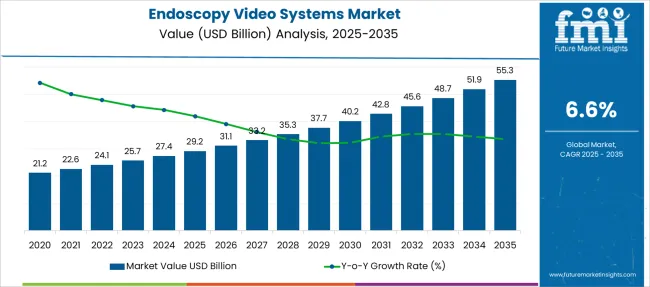
| Metric | Value |
|---|---|
| Endoscopy Video Systems Market Estimated Value in (2025 E) | USD 29.2 billion |
| Endoscopy Video Systems Market Forecast Value in (2035 F) | USD 55.3 billion |
| Forecast CAGR (2025 to 2035) | 6.6% |
The endoscopy video systems market is advancing steadily due to rising demand for minimally invasive procedures, advancements in high definition imaging, and an aging population increasingly susceptible to gastrointestinal disorders. Growing awareness about early diagnosis and increased adoption of endoscopic screening programs are encouraging healthcare providers to invest in advanced visualization technologies.
Improvements in camera resolution, real time image processing, and device integration have significantly improved procedural accuracy and patient outcomes. Additionally, hospital infrastructure upgrades and government initiatives promoting cancer screening are contributing to wider deployment.
The market is poised for continued growth as clinical workflows evolve to prioritize precision, efficiency, and patient safety through technologically enhanced endoscopic solutions.
The market is segmented by Product, Application, and End User and region. By Product, the market is divided into Endoscopic Video Systems and Endoscopy Video Components. In terms of Application, the market is classified into Upper GI Endoscopy, Colonoscopy, Bronchoscopy, Sigmoidoscopy, ENT Endoscopy, and Others. Based on End User, the market is segmented into Hospitals, Specialty Clinics, Diagnostic Imaging Centers, and Ambulatory Surgical Centers. Regionally, the market is classified into North America, Latin America, Western Europe, Eastern Europe, Balkan & Baltic Countries, Russia & Belarus, Central Asia, East Asia, South Asia & Pacific, and the Middle East & Africa.
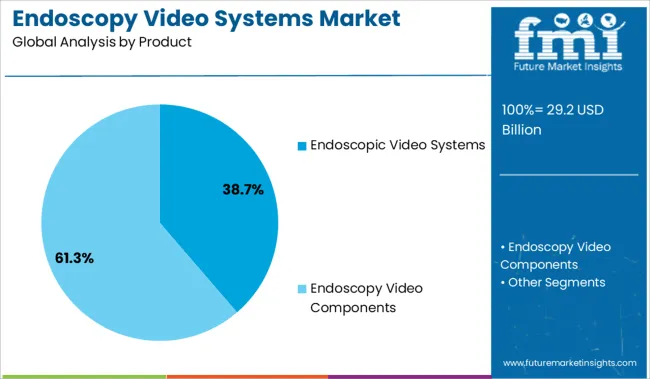
The endoscopic video systems segment is projected to hold 38.70% of total market revenue by 2025 within the product category, positioning it as the leading segment. This is due to its critical role in delivering real time visual guidance during diagnostic and therapeutic procedures.
High resolution video systems enhance visualization of internal structures, which directly supports accurate diagnosis and targeted intervention. Technological advancements in 4K and 3D imaging, along with improved light sources and optical zoom capabilities, have further elevated their clinical value.
The increasing number of endoscopic procedures across specialties such as gastroenterology, pulmonology, and urology has reinforced demand for high performance video systems. These systems are widely integrated into hospital operating rooms and endoscopy suites, contributing to their dominant position in the product category.
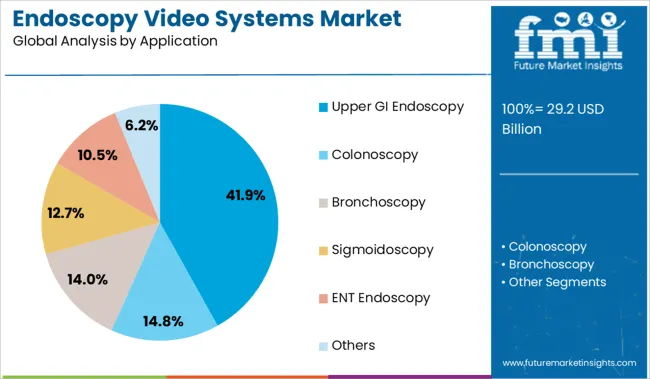
The upper GI endoscopy segment is expected to account for 41.90% of the total market revenue by 2025 within the application category. This is being driven by the high prevalence of upper gastrointestinal disorders such as ulcers, gastritis, and esophageal cancer, which require accurate and timely diagnosis.
Upper GI endoscopy procedures offer direct visualization of the esophagus, stomach, and duodenum, making them essential in both screening and treatment planning. The increasing incidence of lifestyle related gastrointestinal conditions and the push for early detection in high risk populations have further supported demand.
With ongoing innovation in scope design, maneuverability, and image enhancement, this application area continues to be the most utilized in clinical endoscopy settings.
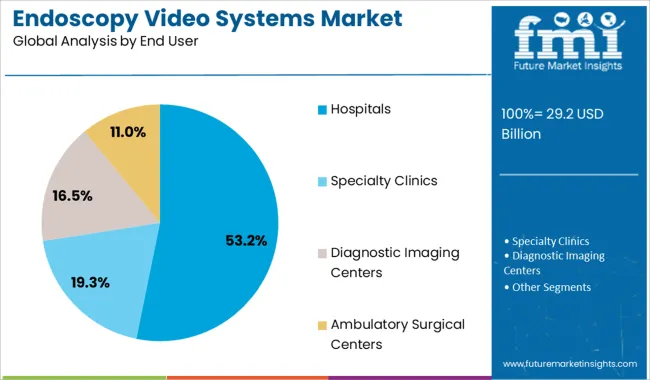
The hospitals segment is projected to contribute 53.20% of overall revenue by 2025 under the end user category, making it the most prominent sector. This is attributed to the availability of advanced infrastructure, skilled personnel, and the capacity to perform complex endoscopic procedures under controlled settings.
Hospitals are investing heavily in integrated endoscopy suites and upgrading to digital video systems to improve diagnostic precision and patient outcomes. The volume of inpatient and outpatient endoscopy procedures performed in hospitals continues to rise, supported by government healthcare initiatives and growing insurance coverage.
The ability to deliver comprehensive care including diagnosis, treatment, and follow up within a single facility further strengthens the hospital segment's leadership in the market.
It is anticipated that this is likely to increase demand for endoscopy video systems in the coming years. Furthermore, the expanding older population increases the number of patients who require endoscopic procedures, resulting in a major increase in the endoscopy video systems market over the projection period.
Patients and clinicians are much more aware of the usage and treatment of modern endoscopic technologies, which is encouraging market growth of endoscopy video systems due to the numerous benefits offered by these devices, such as less invasion and a faster recovery time.
Similarly, the market for endoscopy video systems is expected to grow rapidly over the forecast period due to a significant increase in the number of people sensitive to orthopedic and ophthalmic ailments.
The endoscopic vision systems segment had the highest revenue share (71.5%) in 2024. This is a result of advances in technology that have improved imaging capabilities.
Included among the equipment used for endoscopy visualization are camera heads, light sources, video processors, suction pumps, high-definition monitors, insufflators, and other devices. Two major elements that have contributed to the segment's growth are the aging population and the rise in endoscopic operations.
Generally speaking, there are seven key regions that make up the endoscopy video systems market: North America, Latin America, Europe, East Asia, South Asia, Oceania, and the Middle East and Africa.
North America dominates the endoscopy video system market on a global scale. The rising incidence of stomach and colorectal cancers, as well as the increased need for cutting-edge diagnostic methods, are some of the variables that contribute to the dominant share.
Due to the rising expense of treating cancer, the high prevalence of the elderly, and the rise in endoscopic treatments, the European endoscopy video systems market is also lagging behind the global industry in terms of revenue.
Due to the strategic presence of important players like Olympus and Fujifilm, the East Asian region is expected to experience profitable growth.
The endoscopy video systems market is fragmented, with a number of competitors vying for market share. The producers of endoscopy video systems work hard to create devices that are accurate and effective in every task they carry out.
The manufacturers' increasing willingness to engage in R&D projects in quest of novel processes and technologies is also having an impact on the market's rate of expansion for endoscopic video systems.
The position of a particular player in the endoscopy video systems market is determined by appealing marketing tactics and the efficacy of the endoscopy video systems. The producers of endoscopic video systems routinely engage in mergers, acquisitions, collaborations, joint ventures, and partnerships in an effort to further enhance their positions in the market.
SonoScape, Johnson & Johnson, Stryker, Fujifilm Global, Olympus, Medtronic, Kairos Co. Ltd., BR Surgical, GIMMI GmbH, Mindary, Perlong, and Boston Scientific are a few notable market participants. The ELUXEO Surgical System was introduced by Fujifilm Corporation in July 2024. It offers superior visualisation and can execute both rigid and flexible procedures from a single tower.
The market is expected to grow as a result of the increasing incidence of illnesses such as colorectal cancer, gastrointestinal problems, pancreatic abnormalities, and urological, gynecological, and respiratory disorders. The World Cancer Research Fund reports that colorectal cancer is the second most prevalent cancer in women and the third most prevalent cancer in men.
In the forthcoming years, it is projected that this will increase demand for endoscopic procedures. In addition, the growing elderly population increases the number of patients needing endoscopic operations as a result the endoscopy systems market will grow significantly over the forecast period.
Due to the multiple benefits offered by these devices, including less invasion and a quicker recovery time, patients and physicians are becoming more and more aware of the use and treatment of advanced endoscopic technologies, which is boosting market growth. Similarly, it is anticipated that the market will develop exponentially during the projected period due to the sharp rise in the number of individuals who are susceptible to orthopedic, and ophthalmic illnesses.
The endoscopy video systems market is broadly divided into seven major regions, North America, Latin America, Europe, East Asia, South Asia, Oceania, and the Middle East and Africa.
Globally, the market for endoscopy video systems is dominated by North America. The increasing prevalence of colorectal and gastric cancers as well as the rising need for advanced diagnostic techniques are factors that contribute to the dominant share.
The European endoscopy video systems market is also second in line in the global market due rising cost burden of cancer, the high presence of the age population, and the growing number of endoscopic procedures.
The East Asian region is predicted to show lucrative growth owing to the strategic presence of key players such as Olympus and Fujifilm.
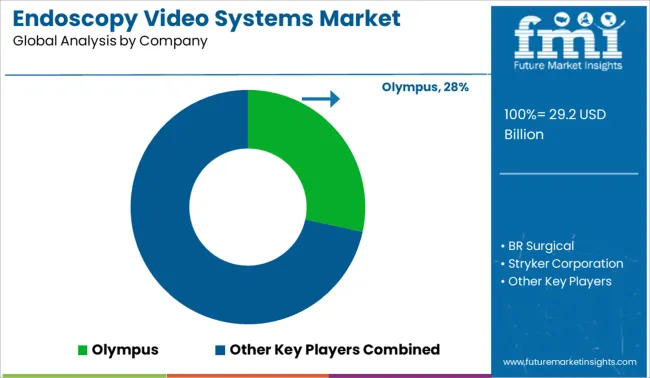
Olympus, BR Surgical, Stryker Corporation, Mindary, Fujifilm Global, Boston Scientific, Medtronic, Smith & Nephew plc., Richard Wolf GmBH, CONMED Corporation, B.Braun Melsungen, SonoScape, Perlong.
| Report Attributes | Details |
|---|---|
| Growth Rate | CAGR of 6.6% 2025 to 2035 |
| Base Year for Estimation | 2024 |
| Historical Data | 2012 to 2024 |
| Forecast Period | 2025 to 2035 |
| Qualitative Units | Revenue in USD Billion, Volume in Units, and CAGR from 2025 to 2035 |
| Report Coverage | Revenue Forecast, Volume Forecast, Company Ranking, Competitive Landscape, Growth Factors, Trends, and Pricing Analysis |
| Segment Covered | Product, Application, End User, Region |
| Region Covered | North America; Latin America; Europe; East Asia; South Asia; Oceania; Middle East & Africa |
| Key Countries Profiled | USA, Canada, Brazil, Mexico, Germany, UK, France, Spain, Italy, China, Japan, South Korea, Malaysia, Singapore, Australia, New Zealand, GCC, South Africa, Israel |
| Key Players | Olympus; BR Surgical; Stryker Corporation; Mindary; Fujifilm Global; Boston Scientific; Medtronic; Smith & Nephew plc.; Richard Wolf GmBH; CONMED Corporation; B.Braun Melsungen; SonoScape; Perlong |
| Customization | Available Upon Request |
The global endoscopy video systems market is estimated to be valued at USD 29.2 billion in 2025.
The market size for the endoscopy video systems market is projected to reach USD 55.3 billion by 2035.
The endoscopy video systems market is expected to grow at a 6.6% CAGR between 2025 and 2035.
The key product types in endoscopy video systems market are endoscopic video systems, _standard definition (sd) visualization systems, _high definition (HD) visualization systems, endoscopy video components, _camera heads, _insufflators, _light sources, _high definition monitors, _suction pumps and _video processors.
In terms of application, upper gi endoscopy segment to command 41.9% share in the endoscopy video systems market in 2025.






Full Research Suite comprises of:
Market outlook & trends analysis
Interviews & case studies
Strategic recommendations
Vendor profiles & capabilities analysis
5-year forecasts
8 regions and 60+ country-level data splits
Market segment data splits
12 months of continuous data updates
DELIVERED AS:
PDF EXCEL ONLINE
Endoscopy Visualization System And Component Market Analysis – Trends & Forecast 2024-2034
Endoscopy Visualization Systems Market Size and Share Forecast Outlook 2025 to 2035
Endoscopy Fluid Management Systems Market Size and Share Forecast Outlook 2025 to 2035
ENT endoscopy Market
Global Neuroendoscopy Devices Market Analysis – Size, Share & Forecast 2023-2033
Veterinary Video Endoscopy Market Analysis by Solution, Product Type, Animal Type, Application, Procedure, End User and Region: Forecast for 2025 to 2035
Unilateral Biportal Endoscopy Market Analysis – Size, Share & Forecast 2024-2034
Video on Demand (VoD) Service Market Size and Share Forecast Outlook 2025 to 2035
Video Processing Platform Market Size and Share Forecast Outlook 2025 to 2035
Video Test Equipment Market Size and Share Forecast Outlook 2025 to 2035
Video Game Market Size and Share Forecast Outlook 2025 to 2035
Video As A Sensor Market Size and Share Forecast Outlook 2025 to 2035
Video Encoders Market Size and Share Forecast Outlook 2025 to 2035
Video Conferencing Market Size and Share Forecast Outlook 2025 to 2035
Video Telematics Market Size and Share Forecast Outlook 2025 to 2035
Video Content Management Market Size and Share Forecast Outlook 2025 to 2035
Video Surveillance Storage Market Report - Growth & Demand 2025 to 2035
Video Analytics Market Growth - Trends & Forecast 2025 to 2035
Video Surveillance Market Growth - Trends & Industry Forecast 2025 to 2035
Video Walls Market by Component, Display Technology, Industry, and Region - Growth, Trends, and Forecast Through 2025 to 2035

Thank you!
You will receive an email from our Business Development Manager. Please be sure to check your SPAM/JUNK folder too.
Chat With
MaRIA